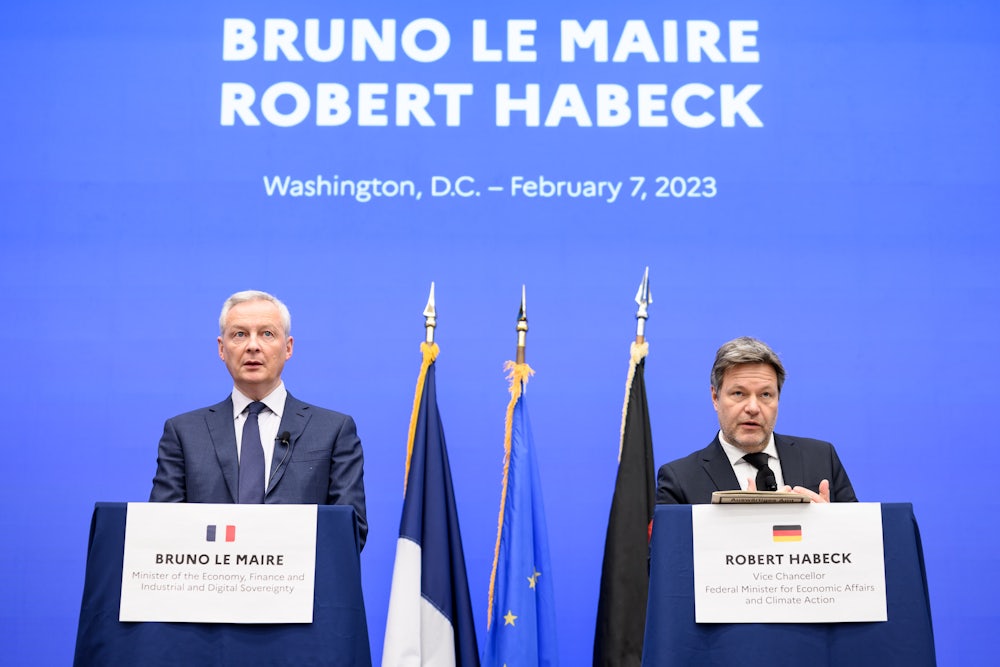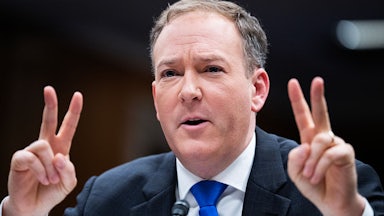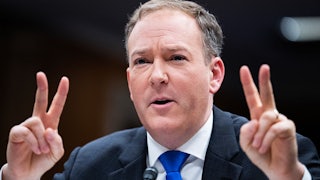A specter is haunting Europe. Last week, high-level meetings in Washington brought representatives from France and Germany to haggle with U.S. officials, hoping to win favorable terms under the Inflation Reduction Act, or IRA. President Biden, meanwhile, had just come out swinging in his State of the Union address with a swaggering defense of the very policies that now have these continental European partners on edge: “Buy American has been the law of the land since 1933,” said Biden. “But for too long, past administrations have found ways to get around it. Not anymore.”
The $369 billion for green technologies allocated by the IRA is much too modest in comparison to the scale of the climate crisis it’s been pitched as addressing. But the size and scope of that law has nevertheless sparked a freak-out among politicians in Europe, who have long held the reputation of outpacing America on all things related to climate policy. The European powers now worry that the EU’s major export industries will be excluded from U.S. tax incentives and that those will prompt companies to flock across the Atlantic in search of a better deal. While they’ve mostly offered a sunny outlook about their discussions in Washington with U.S. Trade Representative Katherine Tai and Treasury Secretary Janet Yellen, among others, French and German economy ministers Bruno Le Maire and Robert Habeck (respectively) admitted that few specifics had been agreed to during those talks. European Commission President Ursula von der Leyen, meanwhile, has announced details of the bloc’s official response to the IRA, a “Green Deal Industrial Plan for the Net-Zero Age,” which builds on several existing programs. But bigger changes are likely coming soon.
This all marks a stark shift from the EU climate policy status quo, the backbone of which has long been its Emissions Trading System. Once considered the gold standard of climate policy, such carbon pricing measures—including taxes and cap-and-trade—have now largely given way to a focus on green industrial policy. That’s thanks to a confluence of factors, from the desire to compete with China’s long-running green industrial policy to the Covid-19 pandemic—during which some governments deployed uncommon and in some cases unprecedented tools to deliver relief and rejigger supply chains for personal protective equipment and vaccines.
The Inflation Reduction Act has put supply chain concerns front and center. In order for an electric vehicle to qualify for its $7,500 tax credit, 50 percent of its battery’s components must be made in North America. That increases by 10 percent each year, meaning that by 2029 all electric vehicle batteries hoping to get a credit will need to be made on this continent. Forty percent of the critical minerals used in E.V.s need to come from the U.S. or a country with which it has a free trade agreement to get the same benefit. Despite being longtime allies, the U.S. does not have such an agreement with the EU. Practically speaking, that means stateside car buyers can get $7,500 off a U.S.-made E.V. but will pay full price for a German or French-made model, putting foreign automakers at a disadvantage in the world’s biggest market for imported cars.
These measures in the IRA have left the EU playing catch-up at a delicate time. Not long after the Covid-19 pandemic exposed supply chain vulnerabilities the world over, Russia’s invasion of Ukraine prompted a range of Western sanctions that left even Europe’s largest economies scrambling to meet energy demands and keep prices from skyrocketing. This has been a particularly acute problem for Germany, where the manufacturing base in sectors such as steel and chemicals has relied heavily on gas that once flowed freely from Russia. The IRA has compounded fears that energy-intensive businesses will relocate in search of both cheaper fuel and subsidies to develop low-carbon alternatives like green hydrogen.
The Treasury has punted on exactly how and when the IRA’s “buy local” requirements will be rolled out, perhaps out of deference to European allies who protested last fall that the “protectionist” bill runs afoul of World Trade Organization rules.
Tensions have smoothed a bit since, with Europe’s top brass having seemingly moved, as Politico recently put it, from anger to acceptance. On Friday, European Commission leaders announced their support for “targeted, temporary and proportionate” measures to stay competitive with the U.S. That will reportedly include a relaxation of state aid rules, which prevent the sort of local content requirements included in the IRA on the grounds that they “distort competition.” European Commission Executive Vice President Margrethe Vestager called for expanding the Temporary Crisis Framework—a pandemic-inspired relaxation of such rules—into a Temporary Crisis and Transition Framework. Calling the IRA a “threat to the competitiveness of specific key sectors for the green transition of the European industry,” she outlined an update of state aid rules to get funds out the door more quickly and target investments toward green sectors most at risk of losing business to the U.S. The Commission similarly plans to introduce a Net-Zero Industry Act to expedite permitting for green projects, as well as an initiative to recycle and diversify supply chains for the raw material needed to produce electric vehicle batteries and energy storage.
Even if all of the above moves forward, the bloc remains severely constrained in its ability to fund such projects. For now there is some money available for investments in decarbonization, including from to-be-repurposed pandemic recovery vehicles. But those will largely run out by 2027, says Janek Steitz, director of the Berlin-based think tank Dezernat Zukunft.
Though there is relatively broad support for relaxing state aid rules, the more controversial question is whether the European Union will start deficit spending itself and allow states more flexibility to do so individually. Currently, EU members contribute funds for bloc-wide initiatives based on their relative size. “Richer member states are opposed to enlarging the joint European budget and opposed to taking on joint European debt because that would mean the richer states subsidize the costs of that for the less wealthy countries,” Steitz explains. Poorer countries also worry that new spending on green industrial policy could see benefits flow inordinately to already wealthy countries with strong manufacturing bases like Germany and France, exacerbating the bloc’s existing inequalities. That raises additional concerns about lifting state aid rules without more careful planning: Countries with more resources could invest in the green transition while others get left behind—which is exactly what happened during the pandemic. According to a European Commission analysis, 53 percent of approved state aid went to Germany; 24 percent went to France. The remaining countries accounted for 23 percent in total.
Manon Aubry, co-chair of the Left bloc in the European Parliament and a member of La France Insoumise, says more sweeping changes are needed to overhaul the market fundamentalism and inequalities holding back Europe’s response to the climate crisis. “It’s good they have come to the conclusion there is a problem,” she told me on the phone last week. “But they will keep with the same solutions that have put us in that situation. In terms of narrative, we are making progress, but it’s not changing the core issues.” She suggested new taxes on financial transactions and windfall energy profits could be used to raise funds for decarbonization efforts.
She and Steitz each see the fracas over the IRA as an opportunity for a more carefully planned bloc-wide green industrial policy. That could include Germany rethinking an export-led growth model historically premised on cheap Russian gas and domestic wage suppression. “The objective is not to have competition between European states but collaboration,” Aubry said. “The history of the EU is to force competition rather collaboration.” Bizarrely, it could be the United States that helps change that.






